As part of a Fellowship at the Smithsonian Institution Archives, I’m researching the scientific activities of the United States Commission on Fish and Fisheries—today part of both The US Fish and Wildlife Service and National Oceanic and Atmospheric Administration (NOAA).This research is part of my larger dissertation project investigating the impact of aquarium technology in American biology between 1880 and 1930. Established in 1871to investigate and alleviate the problem of diminishing fish stocks, the Commission (which was renamed the Bureau of Fisheries in 1902), used multiple channels to gather information on marine resources. One branch of the organization, entitled the Division of Inquiry (later referred to as the Division of Scientific or Biological Inquiry), operated out of aquatic laboratories throughout the US. Their mission, as stated in a 1907 report, was “The study of the habits, migrations, spawning, diseases, etc., of the aquatic animals sought by man, and the almost equally important study of creatures that serve as food, or act as enemies to those of economic value, is conducted year to year as a fundamental branch of the work in behalf of the fisheries.”
At the beginning of my research I wondered: how did the Division of Inquiry (DI) hope to address such a wide range of questions? The annual reports shed little light on the day-to-day operations. However, in the Bureau of Fisheries Records found at the Archives, I found the logbook of three scientists at the Beaufort, North Carolina laboratory which offered a glimpse of daily events during the summer of 1912.
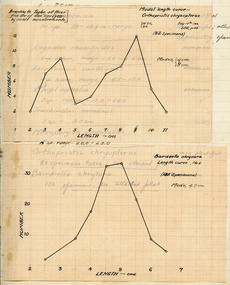
Opened to researchers in 1902, the laboratory at Beaufort was inhabited by a mixture of scientists and students on leave from universities, laboratory workers, and collectors. The scientific work performed at Beaufort was as varied as its residents. The logbook of fishes kept jointly by City College of New York graduate students Lewis Radcliffe, William J. Crozier, and Selig Hecht working throughout the summer for Bureau, recorded how the Division of Inquiry was able to focus on multiple levels of analysis in the study of the wide range of subjects they enumerated in their mission statement.
The study of the habits, migrations, and spawning of fishes required the catch of large amounts of fishes off the North Carolina coast. Daily, large research vessels left the Beaufort laboratory to fish the surrounding waters. The biologists on board took stock of the amount of each species caught, as well as their maturity level, in order to ascertain when the fishes migrated and spawned. Seeing the graphs of these hauls in the logbooks demonstrates how scientists were synthesizing these large catches of fishes into usable data.
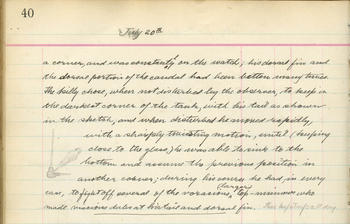
The individual specimen was as important as the aggregate group. Thousands of fishes were hauled in the nets, only to be picked through by scientists looking for specimens to describe and preserve for future work. Each specimen was weighed and measured; the sex, as well as any noticeable characteristics, were noted; and a necropsy (an autopsy performed on an animal) was performed to ascertain what the fish had eaten. While everyday specimens were examined to get a general understanding of the habits of the area fishes, the new or unusual species was especially coveted. Lewis Radcliffe was so excited to see a Cobia (Rachycentron canadum) in the shallower waters near the laboratory dock (they usually live in the open ocean), he hurriedly caught the oversized fish with the only collecting tool he had on hand—his hat! Through analyzing these entries, I could see what information was important for the scientists to catalog so that the life history of each species was built during succeeding years of research at Beaufort.
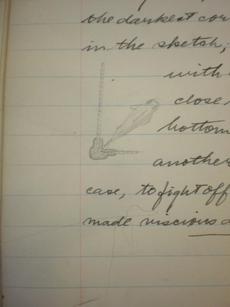
Living specimens were brought to the laboratory aquariums for further observation, illustration, and experimental study. The drawing of the fish that appears to the right was made after observing a peculiar behavior of predation between the much larger mummichog (Fundulus heteroclitus heteroclitus) and a group of small pupfish (Cyprinodon) that were attacking it. The logbooks show a particular interest in transferring living animals from the larger marine environment into the laboratory so that they could be viewed for extended periods of time, suggesting that viewing living specimens and understanding behavior were also important to biologists.
While the mission of the Division of Inquiry at first seemed overly broad, by studying the logbooks I was able to see that scientists at these stations utilized different tools and methods for building a vision of the marine environment from the description of individual specimens to the analysis of migration patterns and animal behavior of whole species.
Produced by the Smithsonian Institution Archives. For copyright questions, please see the Terms of Use.

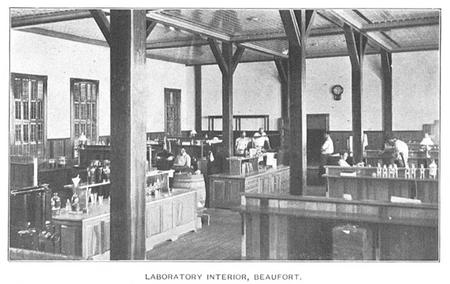
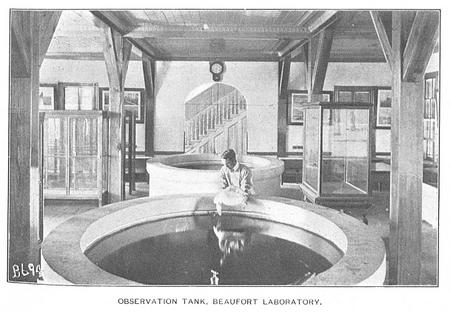
Leave a Comment